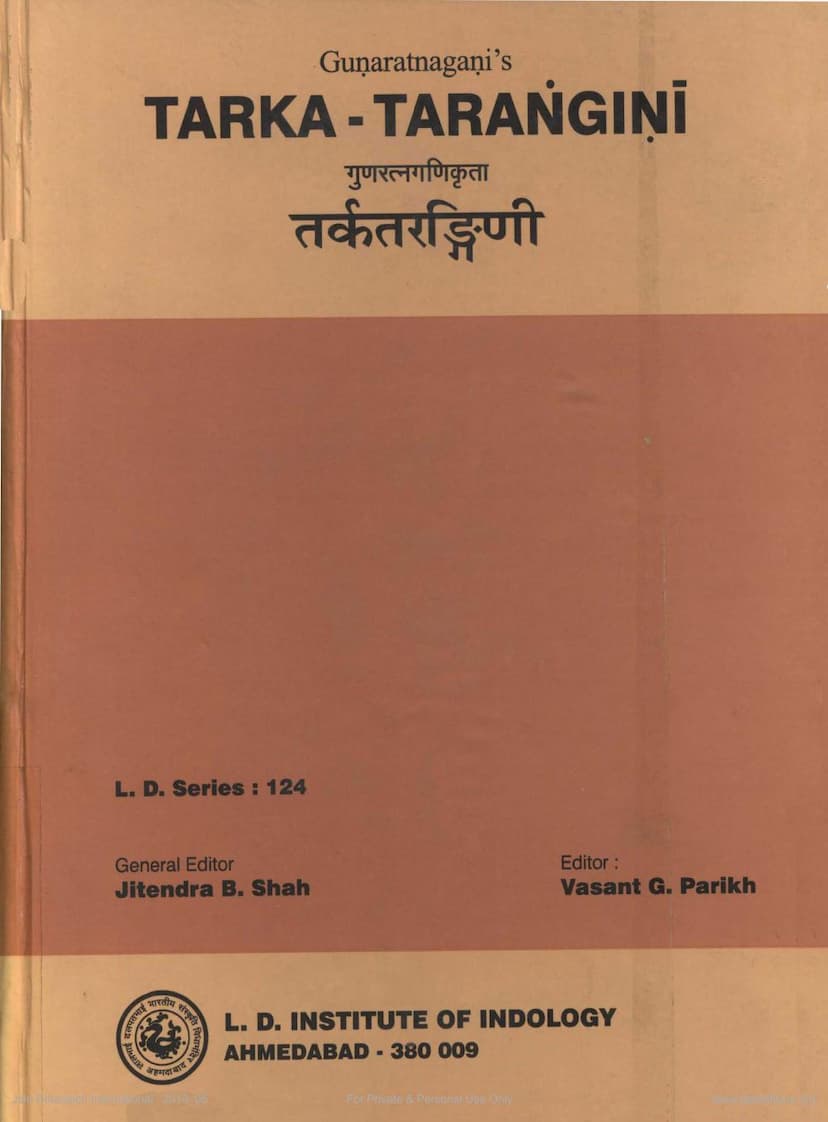Tarkatarangini
Added to library: September 2, 2025

Summary
Here's a comprehensive summary of the Jain text "Tarkatarangini" by Gunaratna Gani, based on the provided information:
Book Title: Tarkatarangini (तर्कतरङ्गिणी) Author: Gunaratna Gani (गुणरत्नगणि) Publisher: L. D. Institute of Indology, Ahmedabad Series: L. D. Series: 124 Editor: Vasant G. Parikh (वसंत जी. परीख) First Edition: 2001
Overview:
"Tarkatarangini" is a significant commentary (Tippani) written by the learned Jain muni, Gunaratna Gani, on the "Tarkabhasāprakasika" (Tpk.) by Govardhana (Gv.). The original "Tarkabhasā" (Tbh.) is a foundational work in the Nyaya-Vaisheshika schools of Indian philosophy, and Govardhana's commentary itself is an exhaustive volume blending ancient Nyaya with Navya-Nyaya (Neo-Nyaya) and the core principles of Vaisheshika. Gunaratna Gani's work, therefore, acts as a sub-commentary, offering further elaboration and insights.
Author and Date:
Gunaratna Gani, belonging to the Kharatara-gaccha, was a disciple of Vinayasamudra Gani. His lineage traces back to Jinamānikyasūri, who was a contemporary of Jinacandrasūri. Jinacandrasūri lived during the time of the Mughal Emperor Akbar and was contemporary to Hiravijayasuri. Gunaratna Gani completed a major commentary on the Kāvyaprakāśa in V.S. 1610 (A.D. 1553), indicating his flourishing period. The Tarkatarangini was written specifically for his beloved student, Ratnavishala.
Content and Scholarly Contribution:
The Tarkatarangini is noted for its in-depth analysis of several key philosophical concepts within the Nyaya-Vaisheshika systems. Gunaratna Gani, deeply influenced by Navya-Nyaya terminology while maintaining a rare simplicity, engages with various complex problems. His contribution lies in elaborating points that were only briefly touched upon by earlier commentators like Keshavmisra (Ke.) and Govardhana (Gv.). He also introduces and discusses new problems not mentioned by his predecessors.
Key Topics Discussed:
The book covers a wide range of philosophical and logical topics, including:
- Mangalavada (Mṇgala-vāda): Gunaratna Gani provides a detailed discussion on the concept of auspicious beginnings (mangala) and its fruits, presenting and analyzing the views of Udayanacharya, Manikara, Pakshadhara Mishra, and Yagnapati Upadhyaya. He critically examines the purpose of mangala, whether it is the completion of the work, the prior negation of obstacles, or the destruction of obstacles.
- Samasavada (Samāsa-vāda): He elaborates on the nature of compounds (samāsa) as found in the Nyāyasūtra, particularly the "Itaretaradvandva" compound, demonstrating his familiarity with Panini's grammar.
- Mokshavada (Moksha-vāda): A significant portion is dedicated to explaining how knowledge of the sixteen categories leads to final liberation (moksha). He delves into the role of scripture (shastra) and knowledge of reality (tattvajnana) as means to moksha, also referencing the concept of "Kashi-marana-mukti."
- Shastra Pravrutti (Śāstra-pravṛtti): The three-fold division of scriptural inquiry (Uddeśa, Lakshana, Pariksha) is examined in detail, highlighting the analytical rigor of Navya-Nyaya.
- Pramana (Pramāṇa): Gunaratna Gani elaborates on the definition of valid knowledge (prama), causes (kāraṇa), and different types of causes (kāraṇa), including the concept of Asamavayi kāraņa. He discusses various philosophical positions on the validity of knowledge.
- Perception (Pratyaksha): He explains and critiques the Buddhist view of nirvikalpa pratyaksha (non-discursive perception).
- Sense-Object Contact (Sannikarsa): The significance of the six-fold sense-object contact is explored.
- Vyapti (Vyāpti): Following Gangesa, he presents and analyzes multiple definitions of concomitance (vyapti), a crucial concept in inference.
- Hetvabhasas (Hetvābhāsas): He explains the significance of the definitions of fallacies in reasoning (hetvābhāsas), rectifying definitions from Gangesa and identifying subtle differences between them, even suggesting new distinctions (e.g., between Satpratipaksha and Samdeha).
- Shabda (Śabda): His discussion on verbal testimony (shabda) as a source of knowledge is detailed, covering aspects like its eternality, the role of memory, and Lakshana (secondary meaning).
- Carvaka Philosophy: He examines the Carvaka view on pramāna, refuting the notion that perception is the only valid means of knowledge and affirming the independence of verbal testimony (shabda).
- Pramanyavada (Prāmāṇyavāda): He thoroughly discusses the theories of prāmāṇyavāda (theory of validity) from different Mimāṁsā schools (Prabhakara, Kumārila, Murari) and establishes the validity of the Nyaya school's perspective.
- Dissolution (Pralaya): He narrates the controversy between ancient and modern Naiyāyikas regarding the process of dissolution.
- Citra-rupa: He supports the ancient view on citra-rūpa (mixed color) but avoids the fundamental discussion on the pervasiveness of color.
- Samyoga (Samyoga): He skillfully refutes objections regarding karmaja-samyoga (conjunction arising from motion) and argues for samyoga being vyāpyavrtti (pervasively extended).
- Anyathakhyati (Anyathākhyāti): He discusses and refutes the Prabhakara theory of error (akhyāti) while explaining the Naiyāyika theory of Anyathakhyati (misapprehension).
- Siddhanta (Siddhānta): He follows Govardhana in his critique of Keshavmisra on the category of Siddhanta (established doctrine).
Editorial Contribution:
The publication is edited by Dr. Vasant G. Parikh, who is credited with carefully editing the work using various manuscripts available in Jain Bhandaras, including those from the Oriental Institute, Vadodara, and the British Museum, London.
Significance:
"Tarkatarangini" is considered a valuable resource for scholars and students interested in the Nyaya-Vaisheshika schools, particularly for understanding the intricacies of Navya-Nyaya. Gunaratna Gani's scholarship, his ability to explain complex concepts with clarity, and his balanced approach, even when presenting and critiquing Jain and non-Jain philosophical ideas, make this work a significant contribution to Indological studies. The book provides a detailed analysis of the foundational texts and the evolution of thought within these influential Indian philosophical traditions.